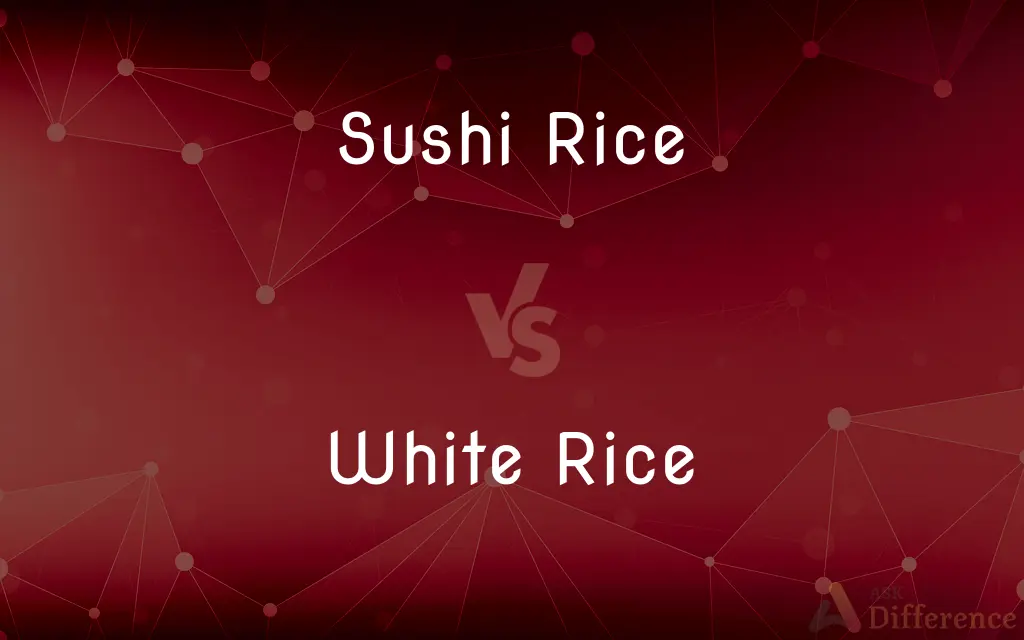Sushi Rice vs. White Rice — What's the Difference?
By Fiza Rafique & Urooj Arif — Published on February 25, 2024
Sushi rice is seasoned and sticky, ideal for sushi, while white rice is plain, versatile, and used in various dishes.

Difference Between Sushi Rice and White Rice
Table of Contents
ADVERTISEMENT
Key Differences
Sushi rice, a key ingredient in sushi, is a short-grain variety known for its ability to stick together, making it perfect for molding into shapes. It's seasoned with a mixture of vinegar, sugar, and salt, giving it a distinctive tangy flavor that complements sushi's other components. White rice, on the other hand, refers to rice that has had its husk, bran, and germ removed, and can range from long-grain to short-grain varieties. It's a staple in many cuisines, appreciated for its neutral flavor and versatility in dishes from stir-fries to pilafs.
The texture of sushi rice sets it apart from most types of white rice. After cooking, sushi rice is cooled and then mixed with its seasoning, which not only flavors the rice but also contributes to a glossy appearance and a sticky consistency. White rice typically has a fluffier texture and individual grains remain more distinct, making it suitable as a side dish or a base for sauces and toppings.
Preparation methods for sushi rice include careful washing, soaking, and cooking, followed by seasoning while the rice is still warm. This process is crucial for achieving the right taste and texture for sushi. White rice preparation is generally simpler, involving rinsing, boiling or steaming, and it's served plain or as part of other culinary creations.
In terms of nutritional content, both sushi rice and plain white rice offer similar benefits, including carbohydrates for energy. However, the seasoning added to sushi rice introduces small amounts of sugar and sodium, which slightly alters its nutritional profile.
Culturally, sushi rice is integral to Japanese cuisine and the art of sushi making. White rice has a broader culinary reach, being a fundamental component in many Asian, Latin American, and Middle Eastern dishes, reflecting the diversity of rice in global cuisines.
ADVERTISEMENT
Comparison Chart
Grain Type
Short-grain, sticky
Varies, often long-grain, fluffy
Seasoning
Vinegar, sugar, salt
None, served plain
Texture
Sticky, holds shapes
Fluffy, grains separate easily
Preparation
Washed, soaked, seasoned
Rinsed, boiled or steamed
Culinary Use
Primarily for sushi
Versatile, used in many dishes
Compare with Definitions
Sushi Rice
A type of rice that is cooled and mixed with seasoning after cooking.
After cooking, the sushi rice was fanned to cool before adding the vinegar mix.
White Rice
A versatile grain that is a staple in various cuisines worldwide.
White rice is used in everything from burritos to stir-fries.
Sushi Rice
A short-grain rice seasoned with vinegar, sugar, and salt for sushi.
The chef prepared the sushi rice with the perfect balance of seasoning.
White Rice
A common side dish that complements a wide range of main courses.
A simple bowl of steamed white rice accompanied the spicy stew.
Sushi Rice
Seasoned rice that complements the flavors of sushi toppings.
The tangy taste of the sushi rice enhanced the fresh fish.
White Rice
Plain rice that can be long-grain, medium-grain, or short-grain.
Long-grain white rice is preferred for its fluffy texture after cooking.
Sushi Rice
Sticky rice used to hold sushi ingredients together.
The sushi rice's stickiness made it easy to roll the maki.
White Rice
The base ingredient in many dishes, from savory to sweet.
The dessert featured sweetened white rice with cinnamon.
Sushi Rice
Rice that is essential for making authentic Japanese sushi.
Quality sushi rice is the foundation of good sushi.
White Rice
Rice with the husk, bran, and germ removed, leaving the white material.
The white rice was served as a side dish with the chicken curry.
Common Curiosities
Can I season white rice to make it like sushi rice?
Seasoning cooked white rice with a mix of vinegar, sugar, and salt can mimic sushi rice's flavor, but the texture may not be identical.
What makes sushi rice different from regular white rice?
Sushi rice is seasoned with vinegar, sugar, and salt, and has a sticky texture, while white rice is plain and can vary in texture.
Is sushi rice only used for sushi?
Primarily, yes, though it can also be used in other Japanese dishes like onigiri (rice balls).
Is there a nutritional difference between sushi rice and white rice?
The main difference comes from the seasoning in sushi rice, adding minimal sugar and sodium.
Can long-grain white rice be used for sushi?
Long-grain rice is less sticky and not ideal for sushi, which relies on the stickiness of short-grain rice to hold together.
Can white rice become sticky like sushi rice?
Some short-grain white rices can be quite sticky when cooked but may not match the specific texture and flavor of sushi rice.
Can I use sushi rice for other types of cooking?
Yes, sushi rice can be used in other dishes, though its sticky texture and seasoning may influence the dish's outcome.
What's the best way to cook sushi rice?
Rinse the rice until the water runs clear, soak if desired, cook it, and then season with the sushi vinegar mixture while warm.
Can I use any white rice to make sushi?
Ideally, sushi should be made with short-grain sushi rice for the right texture and flavor, though some short-grain white rices can be substitutes.
How do I store leftover sushi rice?
Sushi rice is best used fresh but can be stored in the fridge and gently reheated, keeping in mind it may lose some texture.
Why is my sushi rice not sticky enough?
It could be due to insufficient washing, incorrect water-to-rice ratio, or the type of rice used.
Why do sushi chefs fan sushi rice?
Fanning helps cool the rice to the right temperature for sushi and gives it a glossy appearance.
How do I make my white rice fluffier?
Use a slightly larger water-to-rice ratio, rinse the rice thoroughly, and let it steam properly after cooking.
What's the best way to reheat sushi rice?
Add a little water, cover it, and gently reheat it in the microwave or on the stove to restore some of its moisture.
Is sushi rice healthier than white rice?
The health aspects are similar, though sushi rice contains added sugar and salt.
Share Your Discovery

Previous Comparison
Personal Skill vs. Interpersonal Skill
Next Comparison
Milling vs. WeldingAuthor Spotlight
Written by
Fiza RafiqueFiza Rafique is a skilled content writer at AskDifference.com, where she meticulously refines and enhances written pieces. Drawing from her vast editorial expertise, Fiza ensures clarity, accuracy, and precision in every article. Passionate about language, she continually seeks to elevate the quality of content for readers worldwide.
Co-written by
Urooj ArifUrooj is a skilled content writer at Ask Difference, known for her exceptional ability to simplify complex topics into engaging and informative content. With a passion for research and a flair for clear, concise writing, she consistently delivers articles that resonate with our diverse audience.
















































